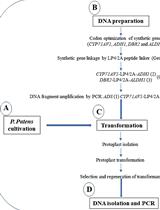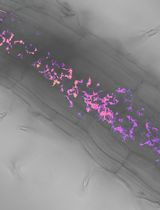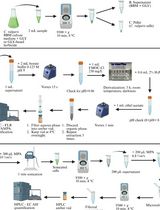- EN - English
- CN - 中文
Application of Silicone Tubing for Robust, Simple, High-throughput, and Time-resolved Analysis of Plant Volatiles in Field Experiments
采用硅胶试管法稳固、简单、高效和快速的分析田间试验植物的挥发性物质
发布: 2015年02月05日第5卷第3期 DOI: 10.21769/BioProtoc.1391 浏览次数: 14957
评审: Tie LiuAnonymous reviewer(s)

相关实验方案

通过在体内直接组装多个DNA片段在青蒿中异源生产青蒿素
Nur Kusaira Khairul Ikram [...] Henrik Toft Simonsen
2023年07月20日 2261 阅读
Abstract
Plant volatiles (PVs) mediate manifold interactions between plants and their biotic and abiotic environments (Dicke and Baldwin, 2010; Holopainen and Gershenzon, 2010). An understanding of the physiological and ecological functions of PVs must therefore be based on measurements of PV emissions under natural conditions. Yet sampling PVs in natural environments is difficult, limited by the need to transport, maintain, and power instruments, or else to employ expensive sorbent devices in replicate. Thus PVs are usually measured in the artificial environments of laboratories or climate chambers. However, polydimethysiloxane (PDMS), a sorbent commonly used for PV sampling (Van Pinxteren et al., 2010; Seethapathy and Górecki, 2012), is available as silicone tubing (ST) for as little as 0.60 €/m (versus 100-550 € apiece for standard PDMS sorbent devices). Small (mm-cm) ST pieces can be placed in any experimental setting and used for headspace sampling with little manipulation of the organism or headspace. ST pieces have absorption kinetics and capacities sufficient to sample plant headspaces on a timescale of minutes to hours, producing biologically meaningful “snapshots” of PV blends. When combined with thermal desorption (TD)-GC-MS analysis - a 40-year-old and widely available technology - ST pieces yield reproducible, sensitive, spatiotemporally resolved, quantitative data from headspace samples taken in natural environments (Kallenbach et al., 2014).
Keywords: Polydimethylsiloxane (聚甲基硅氧烷)Materials and Reagents
- Acetonitrile (gradient grade)
- Methanol (gradient grade)
- Nitrogen (gaseous)
- Scentless soap (Labosol S)
- Argon (gaseous)
Note: Argon provides a clean, inert atmosphere which is heavier than air, for long-term storage of conditioned ST pieces. For shorter time periods, storage under nitrogen is adequate.
Equipment
- Silicone laboratory tubing (ST, 1 mm i.d. x 1.8 mm o.d.) (Carl Roth, catalog number: 9555.1 )
- 4 ml screw-neck glass vials (brown) (Macherey-Nagel, catalog number: 702973 ) and screw caps (N13 PP) (Macherey-Nagel, catalog number: 702051 )
- 1.5 ml screw-neck glass vials (Macherey-Nagel, clear, catalog number: 702282 ; brown, catalog number: 702293 ) and screw caps (N9 polypropylene [PP], Macherey-Nagel, catalog number: 702028)
- Polytetrafluoroethylene (PTFE) seal tape (RS, catalog number: 231-964 )
- Paddle wire
- Retractable-blade utility knife or single-edged razor blade
- Cutting mask (custom-made) for uniformly cutting 5 mm PDMS pieces, made out of polyoxymethylene (POM) (Figure 1A)
Note: PDMS pieces can also be cut manually, but a cutting mask increases uniformity and saves time when cutting large numbers of PDMS pieces.
- Laboratory borosilicate glass bottle (volume: 100-250 ml) (Carl Roth, catalog numbers: A358.1 or A359.1 )
- Stainless steel spatula (Carl Roth, catalog number: 1902.1 )
- Stainless steel forceps (Carl Roth, catalog number: 2687.1 ) and aluminum foil (Carl Roth, catalog number: 0192.1 )
- Glass column (50 ml) with screw-cap ends, containing a size P0 glass frit (Figure 1C)
Note: The glass frit should be sufficiently small to cause a turbulent nitrogen gas flow.
- Polyether ether ketone (PEEK) screw-caps with PTFE lining and stainless steel hose connections, for glass column (Figure 1D)
- Flow meter (5-10 L volume)
- PTFE gas hoses
- Heating oven (max. temperature at least 210 °C)
- Polyethylene tetraphthalate (PET) trapping containers (30-600 ml, Solo or Iso-pack)
Note: The trapping container volume should be as small as possible without significantly changing environmental conditions (e.g. humidity, temperature). This can be tested by enclosing a test sample for the planned trapping period and checking for any visual change (e.g. wilting, condensation) as well as by placing environmental sensors (e.g. temperature, humidity) inside and outside of the trapping container.
- Thermo desorption (TD) unit (Shimadzu, model: TD-20 )
- 89 mm TD sampler tubes (Supelco, catalog number: 28714-U ) and caps with O-rings (Shimadzu, caps, catalog number: 2235461791 and O-rings, catalog number: 2235716691 )
Note: Caps can also be milled from brass as long as the exact dimensions are kept.
- GC-MS (Shimadzu, model: GC-MS-QP2010Ultra )
- 5MS GC column (30 m long, 0.25 mm i.d., 0.25 µm film thickness) (Restek Rtx-5MS)
- WAX column (30 m long, 0.25 mm i.d., 0.25 µm film thickness) (Phenomenex ZB-Wax Plus)
Procedure
文章信息
版权信息
© 2015 The Authors; exclusive licensee Bio-protocol LLC.
如何引用
Kallenbach, M., Veit, D., Eilers, E. J. and Schuman, M. C. (2015). Application of Silicone Tubing for Robust, Simple, High-throughput, and Time-resolved Analysis of Plant Volatiles in Field Experiments. Bio-protocol 5(3): e1391. DOI: 10.21769/BioProtoc.1391.
分类
植物科学 > 植物生物化学 > 其它化合物
植物科学 > 植物新陈代谢 > 其它化合物
您对这篇实验方法有问题吗?
在此处发布您的问题,我们将邀请本文作者来回答。同时,我们会将您的问题发布到Bio-protocol Exchange,以便寻求社区成员的帮助。
Dear Mario,I am about to use your protocol to collect some BVOCs,...
Share
Bluesky
X
Copy link











